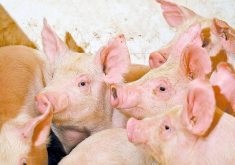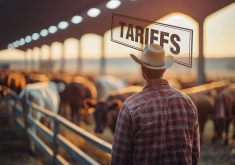If Gerrit Van Hierden, a Fort Macleodarea lamb producer, spends a lot of time in his truck, it’s because he sells direct to farmers’ markets and restaurants
“Of course I spend time on the farm, but a lot of my time is spent marketing,” he says. “My daughter and son-in-law pretty much manage the farm these days and I keep moving to help make sure I have a profitable venture for them to take over one day.”
Together with wife Janet, Van Hierden started out as a dairy farmer in the late 1970s. His wife brought one ewe into the marriage, and eventually that number began to multiply. Van Hierden says that one day they had to make the decision: Stay hobby sheep farmers or grow their flock to commercial levels? They were able to purchase a flock from a neighbour and the business has grown from there.
Read Also

Horns aren’t unlocking anytime soon on livestock transport standards
Standards good enough meet the definition of “humane” animal transportation still vary widely between what what industry wants, what animal rights advocates want and, between the two, what federal regulators decide is good enough.
Today, on top of the 750-head mixed-breed flock, son-in-law Bert runs 160 purebred sheep on their farm. They also have a few cattle, and grow hay and silage for feed. With almost 20 years’ experience as commercial producers, they’ve been in business long enough that they’ve had their share of challenges, but they’ve always managed to weather them.
In their early years, they sold primarily to Eastern Canada, and they had to tailor their breeding program to meet that market. Then they had to change their mix for American customers. That came to an abrupt halt when BSE closed the U.S. border.
“The bottom line is that you have to be flexible,” says Van Hierden. “You have to be prepared to tailor what you do for the market that can make you the most money. And if that market changes, you have to be prepared to change with it.”
Look close to home
Almost 10 years ago, they made another change. Instead of looking at export markets, they decided to respond to demand closer to home. As Canadian consumers became more aware of what they were eating, Van Hierden saw a rise in demand for locally produced lamb.
Van Hierden says he saw two reasons for the shift. First, people are choosing to support local businesses and are willing to pay a bit more. Second, local customers want to know where and how their food is produced, and have shown an increasing interest in food produced more naturally.
“People today are more interested in where their food comes from than they used to be, and quality matters,” Van Hierden says. “So we started selling into farmers’ markets in Calgary and Millarville. We also started approaching chefs to provide our product to their restaurants. Today we sell our lamb into more than 30 restaurants throughout southern Alberta.”
Van Hierden says he has always enjoyed his business, and likes the challenge that comes from knocking on doors and letting people know what he can provide. He says today there’s plenty of demand for everything he can raise, and he hopes that will help him meet his biggest challenge – keeping the business profitable for the next generation.
“Things look great right now, but there are so many things that are out of your control,” Van Hierden says. “Land prices, government regulations and international competition are things you can keep aware of through groups such as Alberta Lamb Producers. But you have to be prepared to keep changing as circumstances change.”
Van Hierden says that for now, as long as he’s able to provide people with what they want and need, and at the same time maintain a profitable family-run business, he’s happy. And he’s content to keep putting mileage on his truck to keep it that way.
———
“The bottom line is that you have to be flexible. You have to be prepared to tailor what you do for the market that can make you the most money. And if that market changes, you have to be prepared to change with it.”
GERRIT VAN HIERDEN
LAMB PRODUCER














